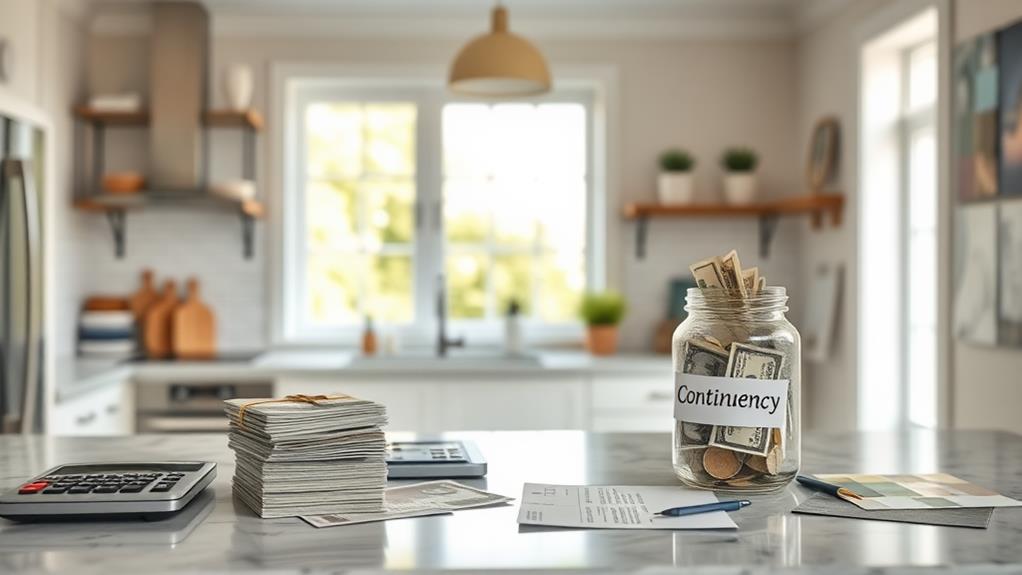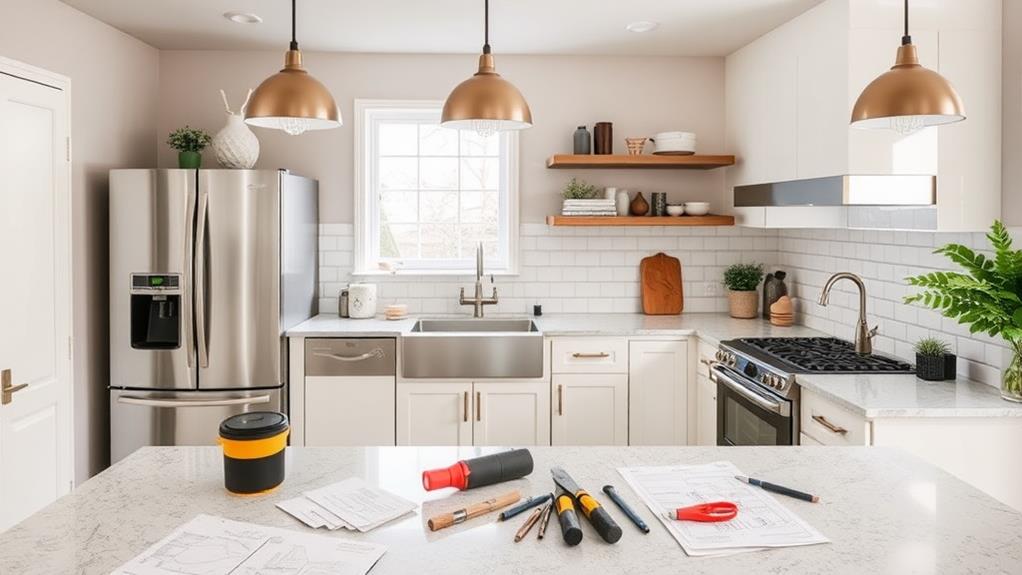To budget your kitchen remodel, start by establishing your overall budget based on personal finances. Break down costs by category, focusing on cabinetry, appliances, and labor. Set aside 10-20% for unexpected expenses. Next, prioritize needs over wants, ensuring essential upgrades take the lead. Explore financing options like home equity loans for better rates. If necessary, consider temporary living arrangements to manage disruptions. Finally, regularly track your spending using budgeting tools to stay on course. Monitoring expenses helps you adjust as needed and keep everything manageable. There's plenty more to uncover about effective budgeting strategies as you advance.
Establish Your Overall Budget

Establishing your overall budget is vital for a successful kitchen remodel. Start by evaluating your personal finances to see how much you can afford to spend without affecting other financial commitments.
Keep in mind that average upscale kitchen remodel costs exceed $80,000, so it's essential to set realistic expectations for your project.
Consider your neighborhood as well; over-improving in modest areas may jeopardize your investment. Aim for a remodeling budget that aligns with local market values to guarantee you get a good return on your investment.
It's wise to allocate 10-20% of your overall budget for unexpected expenses. Older homes might've hidden issues, and this cushion can help you manage those surprises.
Lastly, create a detailed budget breakdown that includes major cost drivers, such as cabinetry (35%), appliances (20%), and labor (20-35%). This will help you prioritize spending and keep your costs manageable.
Breakdown Costs by Category
Understanding the costs associated with a kitchen remodel is vital for effective budgeting. To get a clearer picture of your kitchen remodel costs, it's helpful to break them down by category.
Typically, cabinets take up about 35% of your budget, making them the largest expense. Choosing the right cabinets is critical, as they'll greatly impact both functionality and aesthetics.
Labor usually accounts for 20-35% of your total costs, so don't underestimate the importance of professional help in your planning. Appliances often represent around 20% of your overall budget, with prices ranging widely based on brands and features.
Other costs include windows at 10%, fixtures at 5%, fittings at 3%, and miscellaneous expenses at 7%.
A recommended budget breakdown might look like this: 29% for cabinets, 17% for appliances, 13% for installation, 11% for countertops, and 10% for lighting and electrical work.
Set a Contingency Fund

A well-prepared kitchen remodel can be markedly enhanced by setting aside a contingency fund. This fund is vital for covering unexpected expenses that may pop up during your remodeling project.
To get started, consider these key points:
- Allocate 10-20% of your total budget for the contingency fund.
- Older homes may reveal hidden issues, like outdated wiring or water damage, making this fund indispensable.
- Anticipate potential delays in the project timeline, as having a contingency fund allows for flexibility in managing costs associated with these delays.
- Reassess your budget regularly to accommodate any changes in expenses or project scope.
Prioritize Needs and Wants
When planning your kitchen remodel, it's crucial to prioritize your needs and wants to guarantee the project stays within budget and meets your daily requirements.
Start by identifying essential upgrades that improve kitchen functionality, like energy-efficient appliances and adequate storage solutions, while also considering the importance of hiring reliable local contractors to assure quality work. These should take precedence over luxury items that enhance aesthetics.
Create a list that categorizes features into "needs" and "wants." This helps you focus your budget allocation effectively. Aim to allocate about 70-80% of your budget towards needs, making sure all critical elements are covered before considering optional upgrades.
For instance, if custom cabinetry is too pricey, look into cost-saving alternatives like stock cabinetry, which can free up funds for essentials.
As you progress, regularly revisit and adjust your priorities based on changes in costs or personal preferences. This ongoing evaluation keeps critical functionality at the forefront of your remodel.
Explore Financing Options

When planning your kitchen remodel, exploring different financing options is essential to stay within your budget.
You might consider home equity loans, personal loans, or even refinancing your mortgage, as each can offer unique benefits.
Additionally, think about your savings strategies and how they can help cover costs, making your dream kitchen more attainable without breaking the bank.
Loan Types Overview
Steering through the world of financing options for your kitchen remodel can feel overwhelming, but understanding the various loan types available will help simplify the process.
Here's a quick overview of your options:
- Home Equity Loans: These loans allow you to borrow against your home's value. They often come with lower interest rates and can provide tax deductibility on interest payments.
- Personal Loans: Generally unsecured, personal loans tend to have higher interest rates compared to home equity loans. They offer fixed rates, making budgeting easier.
- Refinancing: By refinancing your existing mortgage, you can access funds for your remodel. However, keep in mind that this may increase your monthly payments and extend your loan term.
- Credit Cards: For smaller purchases, low-interest credit cards can be a practical choice. Just be careful to manage your balances to avoid high-interest debt.
Additionally, don't overlook grants or assistance programs that might be available for home improvements.
Each option has its pros and cons, so consider what best fits your financial situation as you plan your kitchen remodel.
Savings Strategies Consideration
Exploring savings strategies for your kitchen remodel can make a significant difference in how you finance the project. One popular option is a home equity loan, which allows you to borrow against your home's value. The good news is that these loans often come with tax deductibility.
If you prefer not to tap into your home's equity, consider personal loans or refinancing options that offer competitive interest rates. These can provide flexibility for your home improvement project without affecting your home's value.
For smaller purchases, using low-interest credit cards can help manage your cash flow during the remodel. This way, you can avoid the higher interest rates that come with larger loans.
Additionally, look into grants or assistance programs for specific renovations, like energy-efficient upgrades. These can be excellent savings strategies for those on a budget.
As you explore these options, it's essential to weigh the costs and benefits, including interest rates and potential fees.
Make sure your chosen financing method aligns with your overall budget strategy for the cost of remodeling. This careful planning will help guarantee your kitchen remodel stays within reach financially.
Consider Temporary Living Arrangements
Amid the chaos of a kitchen remodel, considering temporary living arrangements can greatly ease the stress of the renovation process. Living in a construction zone can be disruptive and uncomfortable, so weighing your options is vital. Here are some points to think about:
- Temporary Relocation: Renting an apartment or staying in a hotel can provide a peaceful escape during renovations.
- Overall Budget: Factor the costs of alternative housing into your budget to maintain financial clarity and avoid surprises.
- Dining Out Expenses: Anticipate increased dining out or take-out expenses, as cooking at home may not be feasible. Budget for meals outside the home to prevent overspending.
- Makeshift Kitchen: If relocating isn't practical, consider setting up a temporary kitchen in another part of your house, though this may require adjustments to your daily routine.
Communicating with contractors about the expected timeline can help you better plan for temporary living arrangements.
Track Your Spending Regularly

Tracking your spending regularly is crucial to staying on budget during your kitchen remodel. Start by creating a detailed spreadsheet to document your budgeted costs versus actual spending. This allows you to make real-time adjustments and hold yourself accountable. Update your records weekly to catch any potential cost overruns early, so you can take corrective action before they escalate.
Include all expenses in your tracking, such as materials, labor, and miscellaneous costs. This thorough view of your total expenditures helps you stay on track with your established budget.
Setting specific budget tracking milestones, like reviewing expenses at key project phases, can also help you maintain control over your financial progress and avoid overspending.
Consider utilizing budgeting apps or software designed for home renovation projects. These tools can streamline your budget tracking and provide easy access to your financial data for quick decision-making.
Conclusion
By following these seven steps, you can transform your kitchen without breaking the bank. Think of it as building your own culinary kingdom, where every dollar counts. Remember to establish your budget, prioritize what you need, and keep track of your spending. With careful planning and a bit of creativity, you can create a space that's both functional and beautiful. So, roll up your sleeves and get started on your kitchen remodel adventure!


Leave a Reply